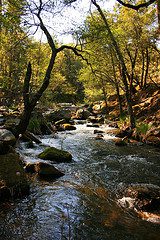The President made a big to-do about climate change in his State of the Union speech the other day, and focused particularly on the need for more clean energy from solar, wind, and natural gas and less from dirty coal. It sounds like the president wants to put a lot of resources into cleaning up our air. Which is great, but here at the community level, the more obvious environmental threats are to our waters.
There are the issues that make the national headlines: Coal mining has never been very good for streams, many of which have turned orange from acid mine drainage. We are turning to natural gas as a clean alternative to coal. But communities in Pennsylvania and elsewhere report that fracking for natural gas isn't very good for groundwater. So which kind of water pollution are we more willing to tolerate?
Then there are water issues that are more regional in nature.
In the Mid-Atlantic the condition of the Chesapeake Bay, a prime fishing and recreational resource, occupies every community's attention. That's because the EPA has mandated that much less cow poop, partially treated human waste, fertilizer, and other nasty things be dumped into rivers and lakes that drain into the bay. This mandate translates into potential penalties for towns and counties that don't spend a lot of money to fence cows out of streams and retrofit their wastewater plants to make them top of the line. Very little federal resources seem to be available to help pay for these things.
For the average person in a rural area, a septic system and drainfield is a fundamental component of life. Septic systems are the primary means of disposal of wastewater for the majority of rural America, and in many suburban areas as well. Yet these systems provide minimal treatment and are prone to failure. Where these systems are located near rivers, streams and lakes, the risk of contamination is comparable to that of dumping directly into the water itself. Not that anyone would advocate going back to the days when many of our rivers and lakes were treated as open sewers. The alternative to septics is central wastewater treatment, but this is much more costly and the treated water still has to go somewhere. Frequently the solution is to put it into the creek.
It costs localities a huge amount of money to address water and sewer issues, and they face a difficult challenge. They need access to these services to grow economically, yet few of them can afford the high-tech systems that result in truly clean water.
All of which is to say that while cleaning up our air may seem like an easy choice to make, because we can suddenly switch from supporting one dirty industry (coal) to one much cleaner one (gas), with water there are no obvious answers. The problems facing communities are technical and each would-be solution can have dramatic side effects. I don't think the president should emphasize water issues over clean air, which is more something to be handled at the federal level. But at the same time, if the feds are going to pressure states and localities to make their waters cleaner, they ought to put some money where that mouth is, too.
(Photo by Divine in the Daily, CC BY-ND.)





Comments